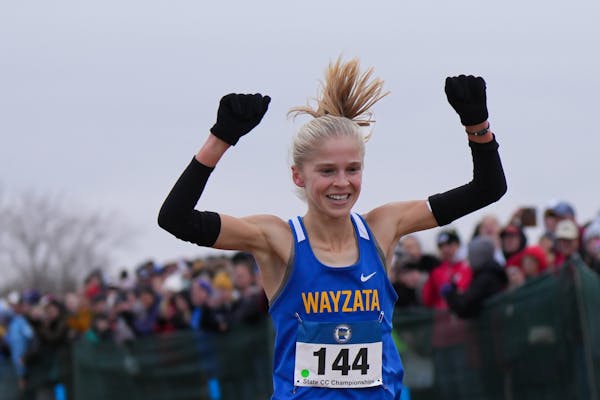NORTHFIELD – Major college baseball players talk with reverence about the possibility of making it to Omaha. Football followers of the North Dakota State Bison have permanent reservations at the Omni Hotel in Frisco, Texas, for the first weekend in January.
Gophers football followers dream of returning again to Pasadena, Calif. as they did a while back. OK, it was twice in a row six decades ago and most Minnesotans making the trip to see their team in the Rose Bowl have passed from this vale of tears, but we're talking about locales that have become the coveted prize at the end of a season.
At a different level — although just as important to and requiring as much or more commitment from the athletes — comes the chance for Minnesota's high school cross-country runners to qualify to be at St. Olaf College in early November.
The 5-kilometer layout that starts in a valley at the bottom of this picturesque campus was hosting the state meet on Saturday for the 29th time in the past three decades (no meet in 2020; COVID-19).
Cross-country is grueling wherever it is contested, but Minnesota and other states in this northern tier offer a special journey during its three-month season.
A fine example of this can be traced right here to this course.
The Showcase at St. Olaf is a well-attended early season event. This year's was held on Sept. 1, a Thursday that started with serious humidity and a temperature that reached 88 degrees.
Runners were going to their knees at the finish, gasping in that heat. Not far away, there was a big meet in Stewartville, and four runners ended up being taken to the hospital for IVs.
On Saturday, for the three classes and six races, boys and girls, the temperature was in the mid-30s. By noon, when the Class A girls were starting, it was in a cold drizzle.
Participants in most fall sports in Minnesota face the same elements, but somehow, the burden of excessive heat seems greater for someone running 3.1 miles up hill and across dale than it does for football players who can go to a sideline and put their face into a fan, or a soccer player who can walk when he feels the urge.
And when it's cold as it was Saturday, being out there in a light garment, with bare legs and arms … brrr.
The first race of the day was Class 3A for girls and perhaps most interesting — due to Abbey Nechanicky, a senior from Wayzata, putting up times that are among the very best for prep runners in the nation.
Sydney Drevlow, then a freshman at Hopkins, finished second to Ali Weimer from St. Michael-Albertville in 2021. Weimer, now a Gophers' No. 1 runner, won at 17:42.1, and Drevlow was 17:57.1.
On Saturday, Drevlow again finished second, and improved her time to 17:39.8. And she was 52 seconds behind Nechanicky. She's small in stature but a true running machine — flying over the rise and pushing herself mightily in a race against time.
That time was 16:47.61, four seconds behind her mark in the recent sectional, but blistering on this St. Olaf course that's rated as challenging.
The democratic nature of cross-country was demonstrated a couple of races later. You can't put a Minneapolis Southwest or a Washburn squad on the same field as a football team from the large suburbs, but those schools had a 1-2 individual finishes in boys 3A:
Aidan Jones from Washburn, followed by Sam Scott from Southwest.
There was what seemed to be a surprise in Class A girls when Nevis' Jade Rypkema burst in front of defending champion Amanda Overgaauw from Murray Country Central/Fulda for the individual win.
A year ago, Rypkema was fifth and over a minute behind Overgaauw. This factor contributed to the 2021 margin: Rypkema had COVID-19 two weeks before the state meet.
Overgaauw's twin sister, Ashley, did outkick a pack to finish third. They are headed to Augustana; Rypkema has committed to Gonzaga.
One rumor here Saturday is there's an element of cross-county coaches that want to explore moving the state meet away from St. Olaf.
Are you nuts, people?
Excellent course; large fieldhouse within 100 yards of the start and finish lines in which participant can assemble; and 30 years of tradition.
You don't move the College World Series out of Omaha, and you don't move the Minnesota state cross-country meet away from St. Olaf.

Reusse: Success on court helped Timberwolves do strong business

Reusse: Taylor's story. 'I just bought the Minnesota Timberwolves.'

Reusse: Back from injury, Towns doesn't have to carry load


